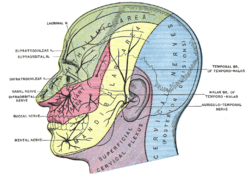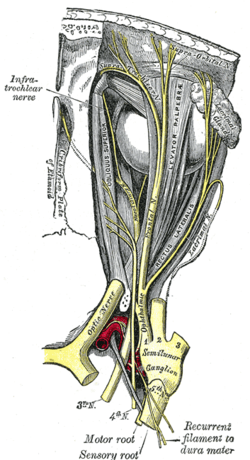Structure and Origin
- The supratrochlear nerve is a terminal branch of the frontal nerve.
- It arises midway between the base and apex of the orbit.
- The supratrochlear nerve passes above the trochlea of the superior oblique muscle.
- It travels anteriorly above the levator palpebrae superioris muscle.
- The nerve exits the orbit through the supraorbital notch or foramen.
Course
- The supratrochlear nerve passes medially above the trochlea of the superior oblique muscle.
- It then travels anteriorly above the levator palpebrae superioris muscle.
- Exiting the orbit through the supraorbital notch or foramen.
- It ascends onto the forehead beneath the corrugator supercilii muscle and frontalis muscle.
- Finally, it divides into sensory branches.
Function
- The supratrochlear nerve provides sensory innervation to the skin and conjunctiva of the upper eyelid.
- It also innervates the skin of the inferomedial forehead.
- The nerve may provide sensory innervation to part of the periosteum of the frontal bone.
Clinical Significance
- The supratrochlear nerve can be anesthetised for surgery of parts of the scalp.
- It is used for small lesions or more extensive injuries to the scalp.
- Often, the nerve is anesthetised alongside the supraorbital artery.
None
The supratrochlear nerve is a branch of the frontal nerve, itself a branch of the ophthalmic nerve (CN V1) from the trigeminal nerve (CN V). It provides sensory innervation to the skin of the forehead and the upper eyelid.
| Supratrochlear nerve | |
|---|---|
 Sensory areas of the head, showing the general distribution of the three divisions of the fifth nerve. (Supratrochlear nerve labeled at upper left.) | |
 Nerves of the orbit. Seen from above. (Supratrochlear nerve visible near top.) | |
| Details | |
| From | Frontal nerve |
| Identifiers | |
| Latin | nervus supratrochlearis |
| TA98 | A14.2.01.024 |
| TA2 | 6203 |
| FMA | 52642 |
| Anatomical terms of neuroanatomy | |
supratrochlear nerve (plural supratrochlear nerves)